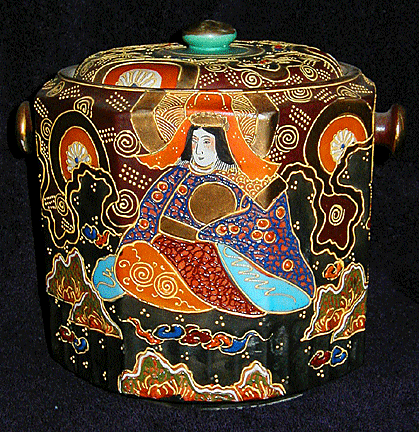 Through
the years, colorful pieces of an old, and sometimes garish style of
ceramics had appeared on flea market and garage and yard sale tables. In
1989, all that changed, for these pieces of pottery and porcelain began
to disappear.
Through
the years, colorful pieces of an old, and sometimes garish style of
ceramics had appeared on flea market and garage and yard sale tables. In
1989, all that changed, for these pieces of pottery and porcelain began
to disappear.
They began to mysteriously disappear from flea market tables, and since
then I've only found one or two pieces a year. What makes this
collectible so vague and why has it remained a mystery for such a long
time?
Satsuma is a term synonymous with a well-known and long-admired form of
Japanese ceramics, first produced just after 1600. Fine Satsuma is a
form of faience pottery covered with a glaze possessing a beautiful
network of crackles with ornamentations of varying colored enamels.
Satsuma-style ware, on the other hand, is both pottery and porcelain,
produced since 1900, that is matt glazed in a decorative manner, with
raised gold and enameled motifs, that’s similar to but more stylized
than the original Satsuma.
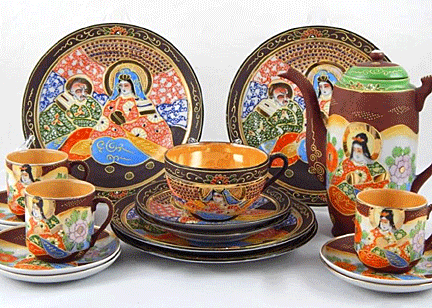
World War I cut off the supply of European hard-paste porcelain to the
United States and Canada. Japan became the new source of supply.
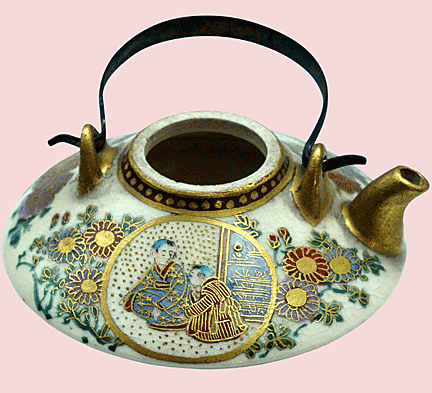 The
original potters of Satsuma were brought from Korea, against their will,
by Shiumazu Yoshihiro in 1596. These potters became known as satsuma
yaki. The pottery industry, from its inception to the time of the
Meiji restoration of the emperor in the late 19th century, was under the
patronage of the daimyo, the lord of a fife having more than 10,000
koku (a measure of the yield of rice of a particular land area).
Satsuma-style wares were produced beginning in the Meiji
period(1868-1911), the Taisho period(1912-1925), and on into the present
Showa period(1926 to the present). A few are still being produced but
the greatest quantities were produced from 1900 to 1935.
The
original potters of Satsuma were brought from Korea, against their will,
by Shiumazu Yoshihiro in 1596. These potters became known as satsuma
yaki. The pottery industry, from its inception to the time of the
Meiji restoration of the emperor in the late 19th century, was under the
patronage of the daimyo, the lord of a fife having more than 10,000
koku (a measure of the yield of rice of a particular land area).
Satsuma-style wares were produced beginning in the Meiji
period(1868-1911), the Taisho period(1912-1925), and on into the present
Showa period(1926 to the present). A few are still being produced but
the greatest quantities were produced from 1900 to 1935.
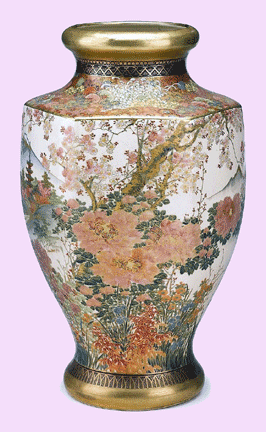 Japan
has been a society where taste was pre-eminent since the establishment
of the first capital at Nara in 710 A.D. A long time under isolation, it
finally began trading with the West and now many items, including
porcelain and faience have been exported. These exports increased mostly
during the Meiji Period (meaning enlightened government) headed by
Emperor Meiji. This period was one of great creative and cultural
changes.
Japan
has been a society where taste was pre-eminent since the establishment
of the first capital at Nara in 710 A.D. A long time under isolation, it
finally began trading with the West and now many items, including
porcelain and faience have been exported. These exports increased mostly
during the Meiji Period (meaning enlightened government) headed by
Emperor Meiji. This period was one of great creative and cultural
changes.
The event with the greatest influence on Japanese pottery was the Cha
no yu (literally meaning hot water for tea), known to Westerners as
the tea ceremony. All Japanese pottery and porcelain articles were
originally produced for use in the Cha no yu. Ceramic utensils
used included: the Cha wan (tea bowl), the choshi (saki
container), the koro(incense burner), the kogo (incense
box), and the mizusasaki (water jar). While these are purely
Japanese, they evolved into tea sets and accessories for use in Western
cultures during the latter part of the 19th century.
Satsuma wasn't always decorated in the manner that we know today—figures
and scenes in brightly colored enamels. It wasn't until 1787 that
Satsuma potters began employing colored enamels, including gold, to
decorate their wares. Figures, including demons and Lohans, or sages who
have reached enlightenment and are endowed with supernatural powers,
were used along with processionals and elaborate landscapes beginning in
1850.
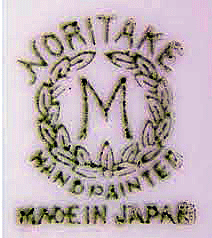 Noritake
was one of the leading companies in the production Satsuma-style wares.
Founded in 1904 by Baron Ichizaemon Morimura and using the Morimura
family insignia as its trademark—an "M" in a wreath—it became the top
exporter of chinaware designed with an appeal to the taste and lifestyle
of Americans.
Noritake
was one of the leading companies in the production Satsuma-style wares.
Founded in 1904 by Baron Ichizaemon Morimura and using the Morimura
family insignia as its trademark—an "M" in a wreath—it became the top
exporter of chinaware designed with an appeal to the taste and lifestyle
of Americans.
During its early years, the production of porcelain blanks, or unpainted
pieces, played an important part in its export trade. Workers painted
these blanks by hand in many different parts of Japan, so the quality of
the finished pieces varied from mediocre to excellent. Many were rich in
gold trim. The blanks carried a backstamp with both words, "Noritake"
and "Nippon"—the Japanese word for Japan—separated by a curved line.
Mass production by Noritake and other companies became possible with the
invention of the jigger mold. Workers placed small quantities of clay
into these molds which formed into exact shapes, then cut off the excess
outside the mold. Finishing porcelain wares had to be done by hand, but
the jigger mold made it possible to produce and export large quantities
of Satsuma-style ware. In fact, Noritake used many of the same molds for
its dinnerware, decorating the pieces with Satsuma-style designs.
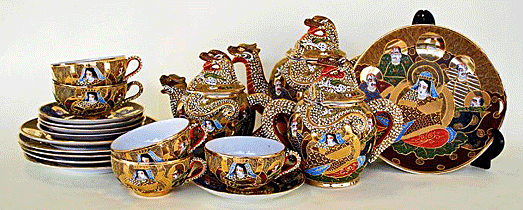
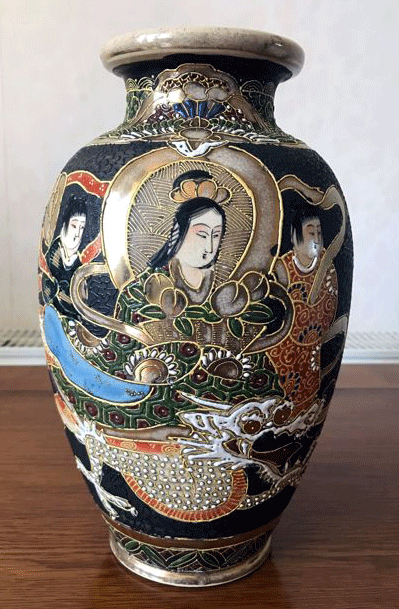 Workers
applied these designs using a method known as slip trailing. In this
procedure, they used a rubber bulb, fitted with a cork into which one or
more quills had been inserted, to "trail" slip, or liquified clay, over
a biscuit fired piece, thus producing raised lines. Consistency was very
important, particularly when they trailed one line over another while
the other was still wet. Both had to sink into one another to form a
level surface if the process was to be successful.
Workers
applied these designs using a method known as slip trailing. In this
procedure, they used a rubber bulb, fitted with a cork into which one or
more quills had been inserted, to "trail" slip, or liquified clay, over
a biscuit fired piece, thus producing raised lines. Consistency was very
important, particularly when they trailed one line over another while
the other was still wet. Both had to sink into one another to form a
level surface if the process was to be successful.
Porcelain pieces often feature Japanese overglaze enamels. It's
difficult to apply these thick enamels and gold. Individual pieces had
to be coated with a wash of gum Arabic or size and the gold applied
using the European method in the form of liquid gold chloride, instead
of the traditional Japanese method, using gold dust mixed with a small
quantity of red pigment to act as an adhesive. This type of raised clay
or enamel decoration, including slip trailing or coralene beading,
became known as moriaga or moriage. Only Noritake wares employed
the moriage techniques.
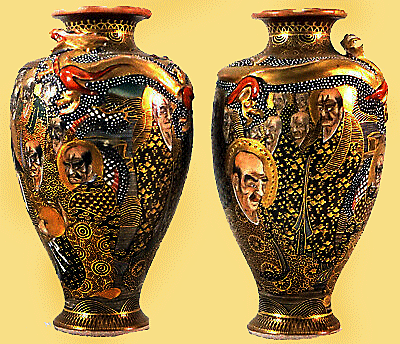 Noritake’s
earliest wares had coralene beading, another of its processes. Workers
formed these "beads" by adding tiny dots of clay to the surface of a
piece, a painstaking task done while the ware was in the biscuit state.
The beading design became part of the ware, often colored in gold, to
make them look like tiny jewels. Later pieces used an imitation coralene
beading formed with dots of enamel without the clay dots underneath.
Noritake’s
earliest wares had coralene beading, another of its processes. Workers
formed these "beads" by adding tiny dots of clay to the surface of a
piece, a painstaking task done while the ware was in the biscuit state.
The beading design became part of the ware, often colored in gold, to
make them look like tiny jewels. Later pieces used an imitation coralene
beading formed with dots of enamel without the clay dots underneath.
During the 1920s and 1930s, Noritake and other potteries made great use
of luster glazing, especially on the interiors of Satsuma-style pieces.
Luster ware stood out from all other kinds of china because of its
brightly colored underglazes. This process used a thin metallic film
over the basic china glaze. Colors used were gold, tan, red, orange,
pearly, blue, and green. Workers fired the china in a low reducing
temperature kiln that produced an iridescent surface to the glaze and
kept the egg-shell thin items from warping. Luster glazing was
especially prevalent on wares with Art Deco or nature motifs.
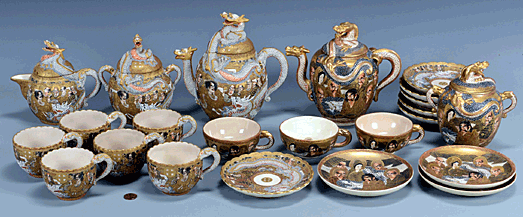
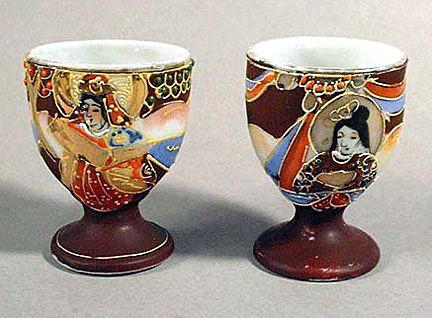 Potteries
like Noritake kept the shapes of Satsuma-style ware generally simple in
line, designing the pieces for specific purposes, such as hatpin
holders, jam jars, egg cups, hair receivers, mayonnaise bowls with
spoons, nut bowls, vases, children's tea sets, cigarette holders,
facepowder boxes, salt cellars, and cookie jars. All of these were in
addition to the traditional tea, coffee, and chocolate sets.
Potteries
like Noritake kept the shapes of Satsuma-style ware generally simple in
line, designing the pieces for specific purposes, such as hatpin
holders, jam jars, egg cups, hair receivers, mayonnaise bowls with
spoons, nut bowls, vases, children's tea sets, cigarette holders,
facepowder boxes, salt cellars, and cookie jars. All of these were in
addition to the traditional tea, coffee, and chocolate sets.
< Back to Collecting Archives
Next Article >
